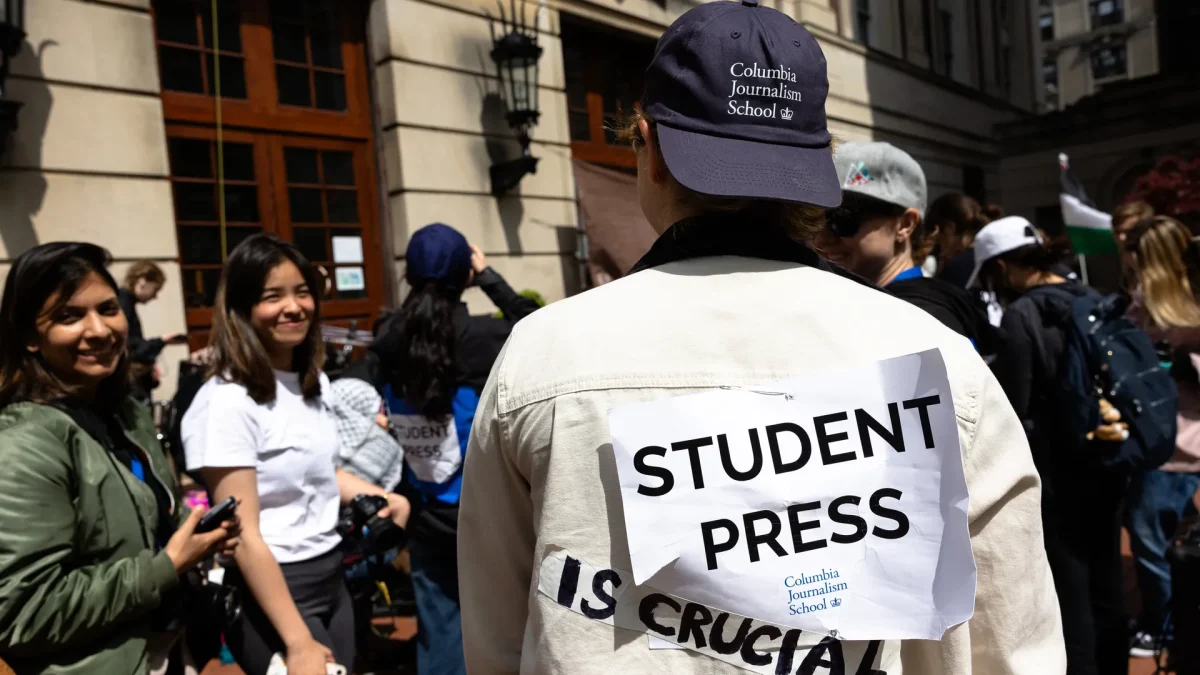In the past nine years, only one student has been expelled from the Minneapolis Public School district, according to the Star Tribune. Instead, students are moved around from school to school in a process called an administrative, or unilateral, transfer. Every school in the district sends and receives transfers. These students arrive any day of the week, any time in the year.
This school year began with a change in administrative transfer policy stemming from a lawsuit filed by a Minneapolis Public School student.
Here today, gone tomorrow
South English teacher Elizabeth Hanson taught at Edison High School for five years. At Edison she estimated that she received around five students per year from administrative transfers.
“They’d come to us from Roosevelt,” Hanson said. “They’d start at Southwest, South, Roosevelt, Edison, and then they’d do something and get moved on to somewhere else too. It was almost like a revolving door.”
The process of a transfer is long and difficult, used mostly as a last attempt. The policy is based on a Minnesota state statute that says that attending a specific public school is a privilege, not a right.
“Students are transferred when certain school safety policies are violated,” stated Roosevelt High principal Michael Bradley in an e-mail. Last year, Roosevelt received 10 transfers, and referred 12. “These are rather serious in nature.”
According the a new school policy about transfers developed in August of 2012, situations meriting a transfer include “repeated fighting between students despite appropriate interventions, significant safety concerns, harassment, or bullying that cannot be addressed in the current setting.” In most instances, the student being transferred has gone through the behavior system of referrals and suspensions, building up to a transfer.
Although counselors and teachers generally have the most direct contact with students, administrators play the largest role in transfers.
“Administrators’ jobs in general is to review situations . . . about any circumstance that would qualify for a student transfer,” South principal Cecilia Saddler said. From the school level, it proceeds to the district’s Student Transfers Office for the final call. This district office did not respond to numerous calls and e-mails looking for comment.
Because of the severity of the punishment, an emphasis is placed on weighing all of the effects of the decision.
“On the positive side, it can be a fresh start for a student, because of conflicts either in the neighborhood or with peers or whatever the situation may be,” said Don Dilla, a South High counselor. “It allows them a chance to start over again, in maybe another setting where they don’t have all of the negative influences around them.”
Hanson looks at the policy differently, coming from a place of teaching in a high-transfer atmosphere. She taught one student coming from Southwest to Edison. “He came into my class and within three weeks of being in my class did the exact same thing he had done to get kicked out of Southwest,” Hanson remembered. “It doesn’t seem to solve the larger problem.”
In terms of academics, stress is added to transferred students’ lives hugely. On top of the strain of whatever situation caused the transfer, the change of switching schools is enormous.
“It’s a lot. You’re not at the school you started your year at. You have to get oriented to a new system, make new friends,” Saddler acknowledged. “It is not easy when that
at. You have to get oriented to a new system, make new friends,” Saddler acknowledged. “It is not easy when that decision is made . . . The one thing that’s important is that a student still feels some dignity after what happened to them.”
Shawn Crenshaw is a counselor at Patrick Henry High School. Last year, Henry transferred 17 students out, and received 11 in return. Crenshaw has had experience working with transferred students, and in behavior management with high-conflict cases.
“I’m on the receiving end – academically, socially, emotionally. It’s my job to make smooth transfers,” said Crenshaw. “Stability is the most important thing. It takes awhile for the teachers to adjust to a whole new learning style. You can’t move [students] place to place and expect them to succeed.”
Teachers also bear the brunt of introducing a new student. The way the transfer system is organized, teachers receive little to no warning, and hardly any background information about the student.
“It’s stressful. You don’t know the history of the student, you haven’t had time to build relationships with them, and they need attention,” Hanson remembered. “Often times if they’ve been admin transferred they need a lot of attention in class, they need help getting caught up, and you still have all the students you’ve had the whole year . . . it’s just a breakdown in your community.”
The district’s transfer policy also stemmed from cost-cutting in the district. An article published by the National Association of Secondary School Principals (NASSP) estimated that an average expulsion cost a school district $170 because of the legal process required by the state for expulsions. In the 2010-2011 school year, the Anoka-Hennepin school district expelled 90 students. According to the cost estimate, Anoka-Hennepin spent roughly $15,300 on expulsions that school year.
Using the same percentage of population expelled in the Minneapolis Public School district as Anoka-Hennepin, the Minneapolis Public Schools would have spent around $13,005 on expulsions in 2010-2011 alone. Administrative transfers bypass much of these costs. Hypothetically, were the district to have removed the same number for students, for all nine years without expulsions, the policy of administrative transfers would have saved $117,045.
Enter Jonah Kaplan
For Jonah Kaplan, a 2012 graduate of Washburn High, the news that he was going to be administratively transferred was not viewed as a fresh slate. He was stunned to hear that he was going to be transferred away from Southwest in his senior year.
“It’s shocking when it happens to you,” Kaplan remembered. “The other big problem with these kinds of policies is that it instills fear in a whole community of people, and, at least in my case, we felt like people were scared. It’s kind of like you disappear, they just pluck you out . . . And that’s not a good culture to have, especially in schools.”
He was also surprised at the lack of transparency available in the process. After an incident that occurred on a school trip in April of 2011, Kaplan was suspended from Southwest for three days. Three turned into five, with recommendation for expulsion. After ten days of deliberation, it was decided that he was not going to be expelled, but administratively transferred.
“It’s basically a de facto expulsion with none of the process,” stated Kaplan. “You kind of assume that there’s going to be some sort of due process when you’re going to be removed from a school . . . Almost every other big city that does a lot of transfers and expulsions and things like that have a more comprehensive process.”
At the time Kaplan was going through the system, the official district guidelines for what merited a transfer was a less than half-page document, with an accompanying sheet outlining the procedure to be followed.
In May of 2011, Kaplan, his parents, and their attorney filed a lawsuit against the district, claiming that Kaplan’s rights had been violated in process of transferring him.
“The first goal of our lawsuit was just to get me a hearing so I could clear my name and go back to Southwest,” Kaplan said. “Once we realized that it was such a kind of bogus system that was harming so many different kids, it seemed like a good opportunity to challenge that, and hopefully get the ball rolling to change the law eventually, or force the district to do something.”
A settlement was reached in November of 2011 that left the district paying the majority of Kaplan’s lawyer’s fees, clearing his record, and allowing him to play sports at Washburn for the remainder of his senior year. But the biggest thing that came out of the lawsuit was that the district was obliged to revise their policy.
Kaplan’s vision for change is to amend the state statute about school attendance, so that it insures a student’s right to stay at a school, unless a comprehensive process shows that staying would pose danger to themselves or other students. “Saying that it’s a privilege and not a right gives the school too much power to take that privilege away for reasons that might not be legitimate.”
“I guess I was just disappointed that they [the district] didn’t show more of an interest in discovering the truth, and having justice in their system,” Kaplan said, looking back at the experience. “They seem to be more interested in protecting their image and self interest and things like that. When you’re dealing with kids and their actual lives, I think you have to value their well-being over whatever image they’re trying to protect.”
Who’s being transferred?
In the 2009-2010 school year, data published by MinnPost showed large racial discrepancies in the population of students transferred.Out of the 267 transfers in the Minneapolis Public School district, 197 were African American. No more than 24 students of any other race were transferred that year.
The Council of State Governments (CSG) Justice Center did a study of nearly one million public high school students in Texas over six years. As well as racial discrepancies, they found that students who were suspended or expelled were twice as likely to repeat that year in school, and three times as likely to be in the juvenile justice system in the next year.
Saddler is aware of this discrepancy. “There is a disproportionately high number of students of color who experience suspensions and transfers,” Saddler stated. “The same [racial] disparity between suspension and behavior exists with students who are not [academically] successful. Are we addressing the actual concern, or are we addressing the reaction?”
Income is also a common player in transfers. Crenshaw noticed that students who experience transfers often come from families with lower income levels, have access to fewer resources, and are on free and reduced lunch. In acknowledging the role poverty plays in a student’s education, Crenshaw looks to his own past.
“People need to know the story behind your life. It creates a comfort level,” Crenshaw said, sharing his history of growing up in a single parent, seven-person household, and working his way through college.
“[Inequalities come from] not knowing and not being comfortable dealing with students from different ethnic groups and cultural groups, and not reaching out to ask questions,” Crenshaw stated. “You can help them be more successful in life because they know you understand. Fear comes from not understanding. We judge before we ask questions.”
Changing the Policy
“Schools in general are reevaluating . . . if there’s a situation that affects the safety of a student, safety of the school, and what to do with that,” Saddler stated, describing an educational trend that is occurring nationally. “What makes the best sense of addressing those issues that is still respectful.”
The CSG Justice Center is part of this trend for change. The School Discipline Consensus Project was established as an 18-month project, backed by the US Departments of Justice and Education, among other organizations. Their end goal is to produce a report that will guide administrators in decreasing dependence on suspensions and expulsions as behavior management tools.
An MPS district committee, formed after the settlement with Kaplan, drafted new transfer guidelines that were released August this year. It is too early to see if the new policy is been effective, but the process for change has been started.
Both Saddler and Bradley emphasized their teams’ focus on the student at the center of the process.
“We are focused on serving every student who comes to Roosevelt,” Bradley stated. “Clearly, I see a focus of my job to build a school in which all students are engaged and academically successful.”
Saddler agreed. “The administrators that I work with really care about what they’re doing . . . they care about the student. It’s about educating kids.”






![A power outage on Friday May 12 before the start of the school day led many students to leave the building and miss parts of first, second and third hour. “[Staff at the front door] said the power might be on at 11, so [we should] come back to school at 11,” recalled freshman Riley Olson. “A lot of people went back home.” However, Principal Afolabi Runsewe claimed and maintains that students were told to stay in the commons and were never given the option to leave school.](https://www.shsoutherner.net/wp-content/uploads/2023/06/power-outage.png)



